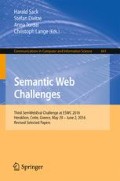Abstract
A top-k shortest path algorithm finds the k shortest paths of a given graph ordered by length. Interpreting graphs as RDF may lead to additional constraints, such as special loop restrictions or path patterns. Thus, traditional algorithms such as the ones by Dijkstra, Yen or Eppstein cannot be applied without further ado. We therefore implemented a solution method based on Eppstein’s algorithm which is thoroughly discussed in this paper. Using this method we were able to solve all tasks of the ESWC 2016 Top-k Shortest Path Challenge while achieving only moderate overhead compared to the original version. However, we also identified some potential for improvements. Additionally, a concept for embedding our algorithm into a SPARQL endpoint is provided.
Access this chapter
Tax calculation will be finalised at checkout
Purchases are for personal use only
Notes
- 1.
This is done since providing a literal as a target node could be ambiguous (e.g. several persons having the same first name). Thus, to apply our algorithm in such use cases, this ambiguity has to be resolved first. For example, one could first search all resources associated with the given literal and then choose the one that is actually meant as the target node (or subsequently run the algorithm on all of them).
- 2.
In particular, we found unparsable datatypes like <http://dbpedia.org/datatype/brake horsepower>. Our first solution removed them, in a later version they were fixed by URL-encoding the blank.
- 3.
Our algorithm is still implemented as a single thread application.
- 4.
Given two resources A and B, A as the source and B as the target, the corresponding SPARQL query is A !:* B. Technically, this searches for zero or more occurrences of properties (indicated by “*”) between A and B not (“!”) matching an introduced fake IRI “:”.
- 5.
References
Aljazzar, H., Leue, S.: K*: a heuristic search algorithm for finding the k shortest paths. Artif. Intell. 175(18), 2129–2154 (2011)
Eppstein, D.: Finding the k shortest paths. SIAM J. Comput. 28(2), 652–673 (1998)
Gubichev, A., Neumann, T.: Path query processing on very large RDF graphs. In: WebDB. Citeseer (2011)
Guo, Y., Pan, Z., Heflin, J.: LUBM: a benchmark for owl knowledge base systems. Web Semant. Sci. Serv. Agents World Wide Web 3(2) (2005)
Jiménez, V.M., Marzal, A.: A lazy version of Eppstein’s K shortest paths algorithm. In: Jansen, K., Margraf, M., Mastrolli, M., Rolim, J.D.P. (eds.) WEA 2003. LNCS, vol. 2647, pp. 179–191. Springer, Heidelberg (2003)
Kostylev, E.V., Reutter, J.L., Romero, M., Vrgoč, D.: SPARQL with property paths. In: Arenas, M., et al. (eds.) ISWC 2015. LNCS, vol. 9366, pp. 3–18. Springer International Publishing, Switzerland (2015)
Lehmann, J., Schüppel, J., Auer, S.: Discovering unknown connections-the dbpedia relationship finder. In: CSSW, vol. 113, pp. 99–110 (2007)
Losemann, K., Martens, W.: The complexity of evaluating path expressions in SPARQL. In: Proceedings of the 31st Symposium on Principles of Database Systems, pp. 101–112. ACM (2012)
Morsey, M., Lehmann, J., Auer, S., Ngonga Ngomo, A.-C.: DBpedia SPARQL benchmark – performance assessment with real queries on real data. In: Aroyo, L., Welty, C., Alani, H., Taylor, J., Bernstein, A., Kagal, L., Noy, N., Blomqvist, E. (eds.) ISWC 2011, Part I. LNCS, vol. 7031, pp. 454–469. Springer, Heidelberg (2011)
Morsey, M., Lehmann, J., Auer, S., Ngonga Ngomo, A.-C.: Usage-centric benchmarking of RDF triple stores. In: Proceedings of the 26th AAAI Conference on Artificial Intelligence (AAAI 2012) (2012)
Przyjaciel-Zablocki, M., Schätzle, A., Hornung, T., Lausen, G.: RDFPath: path query processing on large RDF graphs with MapReduce. In: García-Castro, R., Fensel, D., Antoniou, G. (eds.) ESWC 2011. LNCS, vol. 7117, pp. 50–64. Springer, Heidelberg (2012)
Yen, J.Y.: Finding the k shortest loopless paths in a network. Manag. Sci. 17(11), 712–716 (1971)
Acknowledgement
This work was partially funded by the BMBF project Multimedia Opinion Mining (MOM: 01WI15002).
Author information
Authors and Affiliations
Corresponding author
Editor information
Editors and Affiliations
Rights and permissions
Copyright information
© 2016 Springer International Publishing Switzerland
About this paper
Cite this paper
Hertling, S., Schröder, M., Jilek, C., Dengel, A. (2016). Top-k Shortest Paths in Directed Labeled Multigraphs. In: Sack, H., Dietze, S., Tordai, A., Lange, C. (eds) Semantic Web Challenges. SemWebEval 2016. Communications in Computer and Information Science, vol 641. Springer, Cham. https://doi.org/10.1007/978-3-319-46565-4_16
Download citation
DOI: https://doi.org/10.1007/978-3-319-46565-4_16
Published:
Publisher Name: Springer, Cham
Print ISBN: 978-3-319-46564-7
Online ISBN: 978-3-319-46565-4
eBook Packages: Computer ScienceComputer Science (R0)

